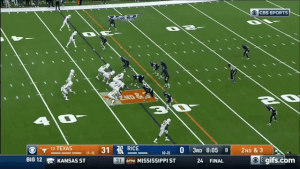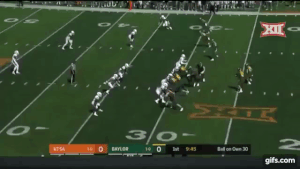Rice football has three games in the books and a lot of film to look through. This week Carter reviews Texas and previews Baylor.
Hey everyone! Welcome back to the film room. Not a lot of positives to take out of that Texas game, sadly, but I do want to highlight one play that shows some great work by the Rice football front seven on defense. Then we’ll switch things up and make this a preview column by looking at a particularly illustrative play from Baylor’s offense in their win against UTSA, so y’all can get an idea of what to expect from them on Saturday.
TEXAS: UT Ball, 2nd and 3, 8:04 3rd quarter

Setup
Texas is in an 11 personnel shotgun spread set. The back is behind Ehlinger and to his right and an H-back to that side of the line. Rice is showing a three man front, with JaVante Hubbard at a 0-tech nose and Myles Adams and Kenneth Orji as stand-up defensive ends.
Prudy Calderon is off the line to the strong side, ready to either cover the H-back or contain a backside QB run. Blaze Alldredge and Anthony Ekpe are at off-ball linebacker, and George Nyakwol has crept up in between the two and is already blitzing into the A-gap at the snap.
The Play
It looks like this is a zone read, because Ehlinger appears to be focusing on Myles Adams at the snap. Since Adams has to go around the H-back, he doesn’t crash quickly enough to tackle the back, and so Ehlinger makes the right read and hands it off. It could be that it’s a called hand-off, with the H chipping Adams long enough to keep him from making the play, but it looks more like he’s trying to get to Prudy Calderon in case Ehlinger keeps it.
Blaze Alldredge’s is the star here. He flows to the B gap, stacks and sheds the right guard, and slides into the backfield to make the tackle. But the rest of the Rice front is great on this play as well. The right tackle can’t stay engaged with Ekpe, who might have managed to stop the play for no gain had the back gotten by Alldredge.
Hubbard backs the reaching right guard two yards into the backfield, as does the 182-lb Nyakwol with UT’s 300-pound center (!!). Both are eventually overpowered, but not till after they’ve clogged up the interior gaps. Orji turns the left tackle perpendicular to the line to seal the edge, preventing the back from bouncing the play outside (which is critical—if Orji doesn’t hold the edge, the back is gone by the time Alldredge sheds his blocker). Even Adams stays in pursuit long enough to have chased down the back if Alldredge had merely plugged his gap instead. It’s a loss of one.
BAYLOR: BU Ball, 1st and 10, 9:45 1st Quarter

Setup
Here’s a play from early in Baylor’s win over UTSA in Week 2. I picked it to illustrate the kind of headaches an aggressive spread run scheme like Baylor’s can cause. Baylor’s in 11 personnel, with all three receivers and the back to the right and the TE to the left. UTSA is in a basic 4-man front nickel package.
The Play
The base run play here is called GT Counter, in which both the backside guard and tackle pull to clear the way for the running back. It’s a popular play these days, in particular being the staple of Oklahoma’s run game. It can be run out of a number of variations and with a variety of options built into it, so it’s a versatile play to have in your book.
Here, it starts with a basic spread option read. The backside defensive end is left unblocked, and the QB will read him, exactly like zone read. If he stays wide, the QB hands it off. If he crashes inside, the QB keeps. Here the DE does what’s called “attacking the mesh”—he sprints upfield to the mesh point, hoping the QB won’t make the read quickly enough and that he’ll be able to make the play no matter who has the ball. It’s a good way to defend these plays if you’ve got a really athletic end, but it’s risky because if the QB decides quickly you can get burned.
Here, Charlie Brewer does what every QB should in this situation (handoff as quickly as possible), and the end takes himself out of the play. From there, UTSA has clogged the middle enough to force Trestan Ebner to cut it back, but once he does there’s nobody in between him and the first down marker, and it’s a big play all the way to the red zone.
The Roost Podcast | Rice Football vs Texas review and Baylor Preview
But this isn’t just a basic option run play—it’s an RPO. Take a look at the innermost slot receiver (what the defense would mark as the No. 3 receiver). As the outer two receivers clear out and set up to block, he goes out for a screen. So actually Brewer’s read here is probably that if the end doesn’t crash inside (or attack the mesh), he pulls the ball out and throws the screen. Some teams, Oklahoma included, will run plays like this but keep the QB run option, making it a true triple option with the screen replacing the pitch.
That play pretty well encapsulates the basic idea of Baylor’s offense. They’re built around a couple of core run concepts, which they use to build out a playbook filled with option runs, play-action and RPOs.
I made the Oklahoma comparison a couple of times, and it’s similar to what they do in their run/option/RPO packages, but without the Air Raid passing roots of Lincoln Riley. It’s more wide open than the old school offense Matt Rhule ran as the head coach at Temple, but it’s still built on running the football. It’s relatively simple for the offensive players to run but deceptively difficult for defensive players to recognize and stay disciplined on the plays. Hopefully Rice football is up to the challenge.

